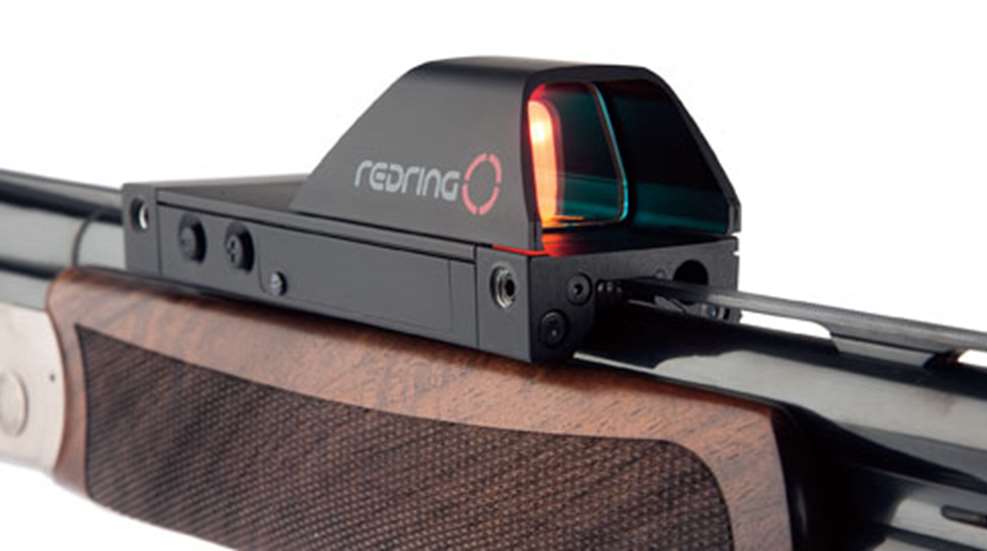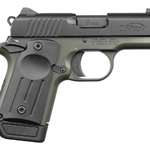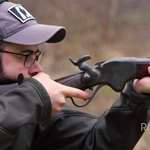
12/26/2012
The Swedish-made Redring shotgun sight is the invention of P. O. Ostergren, who runs a school for hunters and shooters. During his 25 years of teaching, he found that beginning shooters had trouble visualizing shot patterns, and cross-dominant-eyed shooters were difficult to instruct. As a result, the Redring sight was designed to provide both a teaching tool and marksmanship aid in the field.
According to the company, the diameter of the Redring’s circle, or ring, which is projected onto a lens, equates to approximately the shot pattern with an improved cylinder choke at 20 meters (approximately 24 inches at 22 yards). A built-in processor automatically adjusts ring brightness for maximum visibility through diverse lighting conditions; however, the unit does enable manual adjustment via the two buttons on its right side, which also serve to turn the unit on and off. Immediately forward of the aforementioned buttons, and behind a cover, is the battery compartment and a UBS port, enabling the user to download “advanced” settings from the company’s website.
Redring attaches to the rib of any shotgun—with fixed ribs between 5 mm and 11.5 mm in diameter—through a simple system of spacers and clamps fastened with metric Allen screws. The assembly is designed so Redring adds no more than 5 mm to the height of the rib, thereby maintaining a somewhat low line of sight. The provided instructions recommend retightening after the first 25 shots.
Including its mounts and battery, the Redring weighs 6.4 ounces, and it measures 5 3/16-inches long, 1 11/16-inches wide and 1 13/16-inches tall. Powering the unit is a single AAAA 1.5-volt battery, which is provided, and reportedly has a life of 300 hours. After four hours of constant on, the Redring automatically turns off.
We put the Redring in a freezer for two days. When removed, it immediately illuminated, although the thin lens frosted and took about 20 minutes to clear. It is water resistant—not waterproof—and shrugged off the condensation. Mounted on a Remington VersaMax shooting Remington STS 1-ounce target loads at a 16-yard plate the pattern was centered 2 3/4 inches below the point of aim.
Because it was summertime, testing was conducted at a local gun club. One dedicated trap shooter who uses a similar sighting device, immediately liked the feature that automatically adjusts the brightness to the prevailing light conditions. On 16-yard straight-away trap birds, one needed only to place the red ring on the bird and it broke. Angling birds were a different story. The tendency is for the shooter to concentrate on the red ring, and not the target. Granted, the ring shows the location of the pattern, the trick is getting the pattern ahead of the target.
The difficulty of using the Redring became especially apparent for a non-optics user on the skeet field. Straightaway birds from Station 7 low put the pattern right on the target; however, shooting low-house Station 3 birds that require a calculated lead of 3.5 to 4 feet, the sight often caused more confusion than clarity. By the time it was on the bird then moved ahead, the bird was nearly out of bounds. The Redring’s size made it somewhat distracting, making moving it ahead of a bird difficult.
What is the Redring’s value? The purist shotgunner will view the Redring as an impediment, especially for crossing clay targets or when wingshooting; however, those shooters accustomed to using red-dot optics or reflex sights on other long guns will likely see things differently, and more positively. Regardless, the consensus is that the Redring is an excellent device for instructional purposes.
Manufacturer: Redring, Sweden
Importer: Redring USA LLC; (203) 546-3511; www.redringusa.com
Magnification: 1X
Eye Relief: non-critical
Windage and Elevation Adjustment: non-adjusting
Reticle: projected red ring
Length: 53⁄16"
Weight: 6.4 ozs.
Features: projected reticle, anodized aluminum body, automatic light intensity adjustment
Accessories: spacers and clamps, Allen wrenches, battery, USB cable
Suggested Retail Price: $900




































